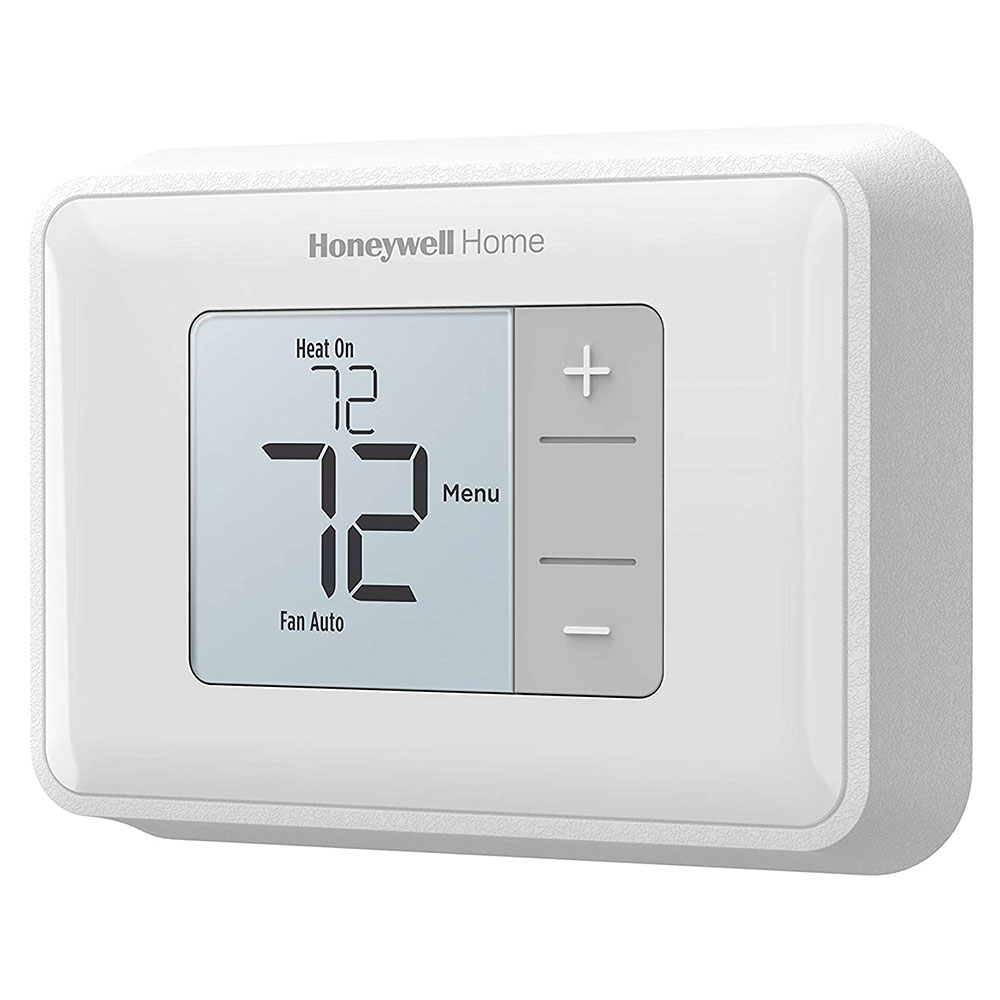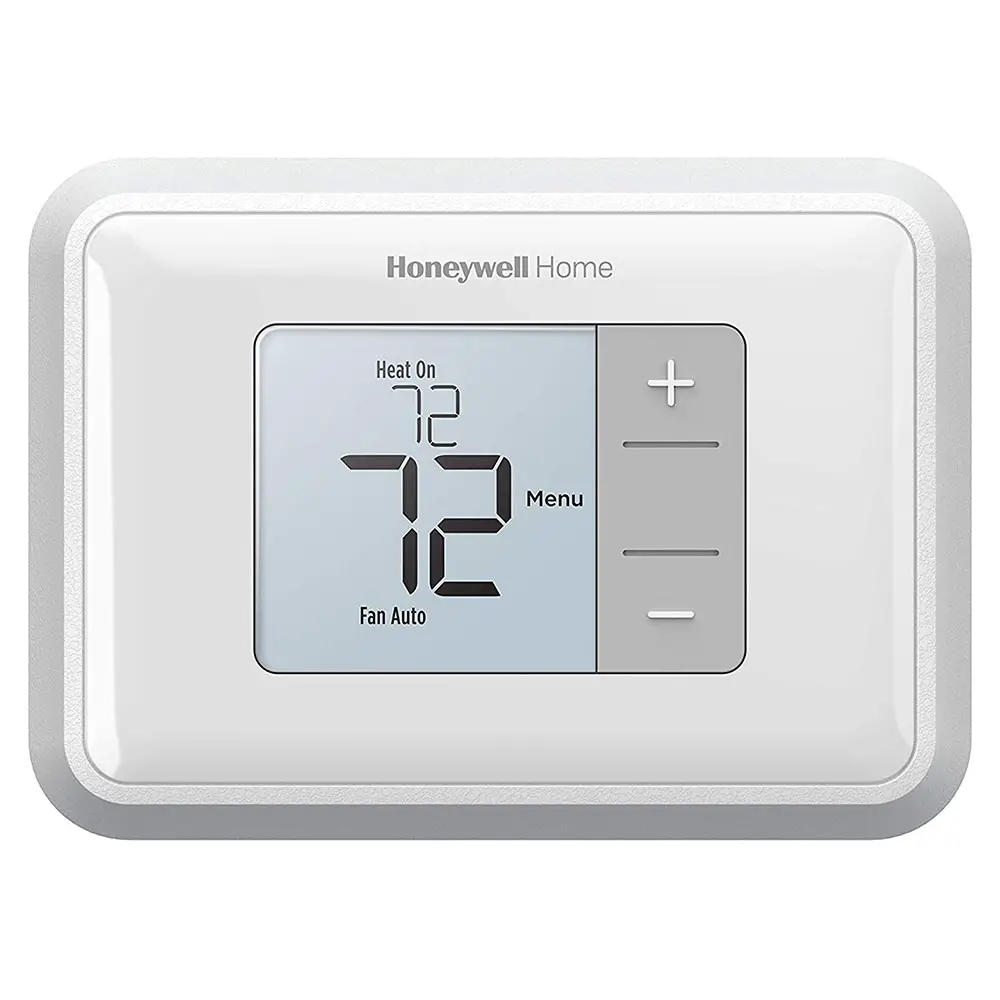Check Best Thermostat Pricing in Amazon
** As an Amazon Associate, I earn from qualifying purchases.
A non-programmable thermostat requires manual adjustments to set and maintain the desired temperature. It does not have scheduling features.
Non-programmable thermostats are straightforward devices that control your home’s heating and cooling systems. They offer simplicity and ease of use, making them ideal for those who prefer manual control over their environment. These thermostats are typically more affordable and less complex than programmable or smart thermostats.
Users manually set the temperature to their comfort level, which remains constant until changed. This type of thermostat is perfect for people with a consistent daily routine or those who do not require advanced scheduling features. They are reliable, user-friendly, and effective for maintaining a stable indoor climate.
- Introduction To Non Programmable Thermostats
- Key Features Of Non Programmable Thermostats
- How Non Programmable Thermostats Work
- Advantages Of Non Programmable Thermostats
- Limitations Of Non Programmable Thermostats
- Ideal Use Cases For Non Programmable Thermostats
- Installation And Maintenance
- Making The Choice: Is A Non Programmable Thermostat Right For You?
- Future Of Temperature Control
- Frequently Asked Questions
- Conclusion
Introduction To Non Programmable Thermostats
Non programmable thermostats are simple devices. They help control home temperature manually. These thermostats are easy to use and very reliable.
The Basics Of Manual Climate Control
Manual climate control means adjusting the temperature yourself. You turn the dial or press buttons to set the desired temperature. There are no schedules or automatic adjustments.
This type of thermostat is usually very straightforward. It has a simple interface with a few buttons or a knob. Anyone can use it without any training. It is a basic yet effective way to maintain home comfort.
| Feature | Non Programmable Thermostat |
|---|---|
| Control | Manual |
| Interface | Simple |
| Scheduling | None |
Contrast With Smart Thermostats
Smart thermostats offer advanced features. They can automate temperature adjustments. They connect to Wi-Fi and can be controlled via smartphone apps. This is very convenient for tech-savvy users.
Non programmable thermostats do not have these features. They require manual adjustments. This makes them less complex but also less flexible.
Smart thermostats can learn your habits. They adjust temperatures based on your routine. Non programmable thermostats do not have this capability.
- Smart thermostats: Automated, Wi-Fi enabled, app-controlled.
- Non programmable thermostats: Manual, simple interface, no automation.
Both types of thermostats have their own advantages. A non programmable thermostat is ideal for those who prefer simplicity. A smart thermostat suits those who enjoy advanced technology.

Credit: www.honeywellstore.com
Key Features Of Non Programmable Thermostats
Non programmable thermostats are popular for their simplicity and reliability. They provide basic temperature control without the need for complex settings. This section explores the key features of non programmable thermostats that make them a preferred choice for many households.
Simplicity Of Design
The simplicity of design is a standout feature. These thermostats come with a straightforward interface. There are no intricate menus or digital displays. Most models feature a basic dial or a few buttons. This makes them easy to understand.
Non programmable thermostats are often more durable. The lack of complex electronics reduces the chance of malfunction. Their design focuses on functionality and ease of use. This makes them perfect for those who prefer a no-fuss approach to temperature control.
Ease Of Use
The ease of use is another major benefit. Users can set their desired temperature with a simple turn of the dial or press of a button. There’s no need to navigate through multiple settings or schedules.
These thermostats are user-friendly for all age groups. They are particularly useful for seniors or those who are not tech-savvy. The basic operation ensures that anyone can control their home’s climate without hassle.
Below is a comparison table highlighting the differences between non programmable and programmable thermostats:
| Feature | Non Programmable Thermostat | Programmable Thermostat |
|---|---|---|
| Design | Simple | Complex |
| Ease of Use | Very High | Moderate |
| Temperature Control | Manual | Automated |
| Settings | Basic | Advanced |
In summary, the key features of non programmable thermostats include their simple design and ease of use. These features make them an excellent choice for anyone seeking straightforward and reliable temperature control.
How Non Programmable Thermostats Work
Understanding how non programmable thermostats work helps you make an informed choice for your home. These devices operate without the need for complex settings or schedules.
Mechanical Vs. Electronic Models
Mechanical thermostats use simple components like bi-metallic strips. These strips expand and contract with temperature changes, activating the heating or cooling system.
Electronic thermostats feature digital displays and use electronic sensors. These sensors detect temperature changes and send signals to your HVAC system.
Temperature Setting Process
Non programmable thermostats allow you to manually set the temperature. This is done using a dial or buttons on the thermostat.
With a mechanical model, you turn a dial to your desired temperature. Electronic models often have up and down buttons for adjusting the temperature.
| Feature | Mechanical Model | Electronic Model |
|---|---|---|
| Temperature Adjustment | Turn Dial | Press Buttons |
| Display | Analog | Digital |
| Sensors | Bi-metallic Strip | Electronic Sensors |
Non programmable thermostats are straightforward and reliable. They are perfect for people who prefer simplicity in controlling their home’s temperature.
Advantages Of Non Programmable Thermostats
Non programmable thermostats are simple devices for controlling home temperatures. They offer several benefits that make them a popular choice among homeowners. Let’s explore some key advantages.
Cost-effectiveness
Non programmable thermostats are generally more affordable than their programmable counterparts. They do not have complex features, which keeps the price low. This makes them an excellent option for budget-conscious homeowners. Additionally, energy savings can be achieved by manually adjusting the settings to suit your needs.
Reliability And Durability
These thermostats are known for their high reliability. Without sophisticated electronics, they are less likely to malfunction. This means fewer repairs and replacements. Their durable construction also ensures they last longer, providing peace of mind for many years.
Lower Maintenance Requirements
Non programmable thermostats require very little maintenance. With fewer components, there are fewer parts that can wear out. This translates to lower maintenance costs. Homeowners can enjoy a hassle-free experience with minimal upkeep.
| Advantages | Description |
|---|---|
| Cost-Effectiveness | Affordable and helps in energy savings. |
| Reliability and Durability | High reliability with fewer malfunctions. |
| Lower Maintenance Requirements | Minimal upkeep needed, reducing costs. |
In summary, non programmable thermostats are a cost-effective, reliable, and low-maintenance option for controlling home temperatures. They are a great choice for those who value simplicity and affordability.
Limitations Of Non Programmable Thermostats
Non programmable thermostats are simple devices for controlling home temperatures. They are straightforward but come with several limitations. Understanding these limitations helps in making informed choices about home heating and cooling systems.
Lack Of Advanced Features
Non programmable thermostats lack advanced features found in modern thermostats. They do not have Wi-Fi connectivity or smart home integration. This means they cannot be controlled remotely using a smartphone or other devices.
These thermostats also lack energy-saving modes. They do not learn user habits or adjust settings automatically. This can lead to less efficient energy use.
Manual Adjustment Requirement
One significant drawback is the need for manual adjustments. Users must change the settings themselves whenever they want to adjust the temperature.
Check Best Thermostat Pricing in Amazon
** As an Amazon Associate, I earn from qualifying purchases.
This manual process can be inconvenient. It requires constant attention, especially during seasonal changes. For families with busy schedules, this can be a major hassle.
Potential For Inefficiency
Non programmable thermostats can be inefficient. They do not adjust temperatures based on occupancy or time of day.
For example, the thermostat will maintain the same temperature even when no one is home. This can result in higher energy bills. Over time, this inefficiency can lead to increased costs and energy waste.
Ideal Use Cases For Non Programmable Thermostats
Non programmable thermostats are simple and easy to use. They are best for people who do not need advanced features. These thermostats are perfect for specific environments and user groups. Let’s explore the ideal use cases for non programmable thermostats.
Suitable Environments
Non programmable thermostats work well in certain places. These places do not need frequent temperature changes. Here are some examples:
- Vacation Homes: These homes are not used every day. A simple thermostat is all you need.
- Rental Properties: Tenants may not want to deal with complex settings.
- Offices: Small offices with stable work hours benefit from a fixed temperature.
- Retail Stores: Stores with regular hours do not need programmable features.
User Demographics
Non programmable thermostats are perfect for specific groups of people. These groups prefer simplicity and ease of use:
- Seniors: Older adults may find programmable thermostats confusing.
- Technologically Averse Individuals: Some people prefer simple devices without extra features.
- Children: Kids can easily adjust the temperature without complex settings.
Non programmable thermostats are easy to use and understand. They fit well in many environments and suit various user groups. They provide a simple solution for temperature control.
Installation And Maintenance
Installing and maintaining a non-programmable thermostat can be easy. This guide will help you with step-by-step instructions and routine maintenance tips.
Step-by-step Installation Guide
Follow these steps to install your non-programmable thermostat:
- Turn off the power to your HVAC system at the circuit breaker.
- Remove the old thermostat by unscrewing it from the wall and disconnecting the wires.
- Label the wires with tape to remember their positions.
- Mount the new thermostat base to the wall using the provided screws.
- Connect the wires to the corresponding terminals on the new thermostat.
- Attach the thermostat cover to the base.
- Turn the power back on at the circuit breaker.
- Test the thermostat to ensure it is working correctly.
These steps will help you install your thermostat efficiently.
Routine Maintenance Tips
Maintain your non-programmable thermostat to ensure it works well:
- Check the thermostat settings every season.
- Clean the thermostat with a soft cloth to remove dust.
- Replace the batteries every year to avoid power issues.
- Inspect the wiring for any signs of wear or damage.
- Calibrate the thermostat if it shows incorrect temperature readings.
These tips will help keep your thermostat in good condition.

Credit: www.amazon.com
Making The Choice: Is A Non Programmable Thermostat Right For You?
Choosing a thermostat for your home can be a tough decision. A non programmable thermostat is a simple device that controls your home’s temperature. It lacks the advanced features of programmable models but offers simplicity and ease of use. Let’s explore if a non programmable thermostat is the right choice for you.
Assessing Your Needs
Before selecting a thermostat, think about your daily routine. Do you have a consistent schedule? If so, a non programmable thermostat may suit your needs. This type of thermostat is ideal for people who stay at home most of the time.
Consider how often you adjust your home’s temperature. If you rarely change it, a non programmable thermostat might be perfect. It allows you to manually set the temperature and forget about it. This simplicity can be a great advantage.
Comparing Costs And Benefits
Non programmable thermostats are usually cheaper than programmable ones. They have fewer features, making them more affordable. If you have a tight budget, this could be a significant benefit.
| Feature | Non Programmable Thermostat | Programmable Thermostat |
|---|---|---|
| Cost | Lower | Higher |
| Ease of Use | Very Simple | Requires Setup |
| Energy Efficiency | Basic | Advanced |
While non programmable thermostats are cheaper, they may not save as much energy. Programmable thermostats can adjust temperatures based on your schedule, saving energy when you’re not home. But if your schedule is stable, a non programmable model might still save you money.
Finally, think about ease of use. Non programmable thermostats are straightforward. You set the temperature manually, and it stays there until you change it. This simplicity can be a significant advantage for many people.
Future Of Temperature Control
The future of temperature control is evolving rapidly. Homes are becoming smarter and more efficient. Thermostats play a crucial role in this transformation. From smart thermostats to non-programmable ones, each type has a unique role. Let’s explore the trends and the role of non-programmable thermostats.
Trends In Thermostat Technology
Thermostat technology is advancing. Here are some key trends:
- Smart thermostats: They can be controlled via smartphones.
- Learning thermostats: They adapt to your habits.
- Wi-Fi connectivity: Allows remote access and control.
- Energy efficiency: Reduces energy consumption.
- Voice control: Compatible with voice assistants.
The Role Of Non Programmable Thermostats In Modern Homes
Non-programmable thermostats are simple and easy to use. They allow manual temperature control. Many people prefer them for their straightforward design.
Here are some benefits of non-programmable thermostats:
- Ease of use: No need to set schedules.
- Cost-effective: Cheaper than smart thermostats.
- Reliable: Fewer components mean fewer malfunctions.
| Feature | Non-Programmable Thermostats | Smart Thermostats |
|---|---|---|
| Control | Manual | Remote and automated |
| Cost | Low | High |
| Complexity | Simple | Complex |
Non-programmable thermostats fit well in many homes. Their simplicity and reliability make them a preferred choice for many users. They continue to play a crucial role even as technology advances.

Credit: www.hutchbiz.com
Frequently Asked Questions
What Is Better, A Programmable Or Non-programmable Thermostat?
A programmable thermostat offers more control and energy savings by adjusting temperatures automatically. Non-programmable models are simpler but less efficient.
Do You Really Need A Programmable Thermostat?
Yes, a programmable thermostat saves energy and money. It automatically adjusts temperatures based on your schedule. This increases comfort and efficiency.
What Is The Difference Between Programmable And Non-programmable?
Programmable devices allow user customization and scheduling. Non-programmable devices operate only with manual settings and lack advanced customization options.
What Is The Difference Between A Standard And Programmable Thermostat?
A standard thermostat maintains a set temperature. A programmable thermostat allows scheduling temperature changes for energy efficiency and comfort.
Conclusion
Non programmable thermostats offer simplicity and ease of use. They are perfect for those seeking straightforward temperature control. While they lack advanced features, they are cost-effective and reliable. Understanding these thermostats helps you make an informed decision for your home.
Choose what best fits your lifestyle and comfort needs.
Check Best Thermostat Pricing in Amazon
** As an Amazon Associate, I earn from qualifying purchases.


